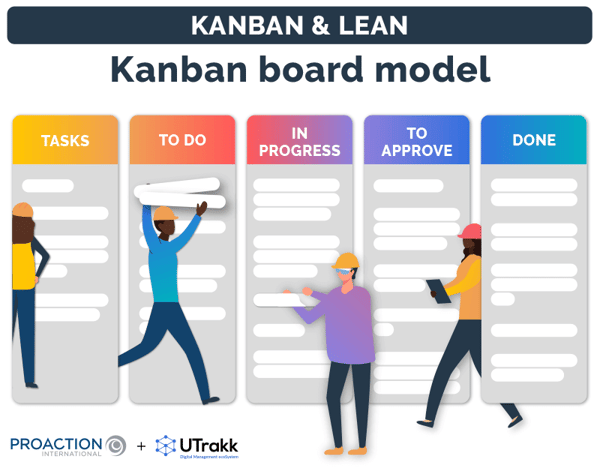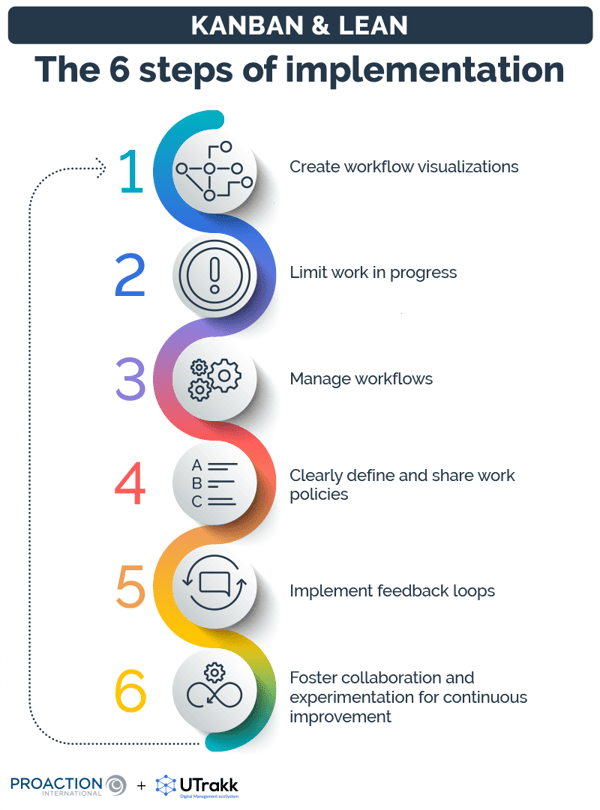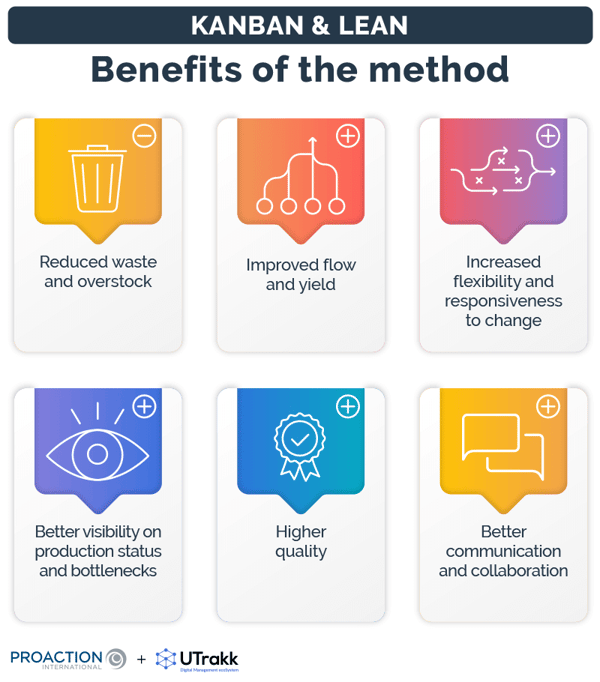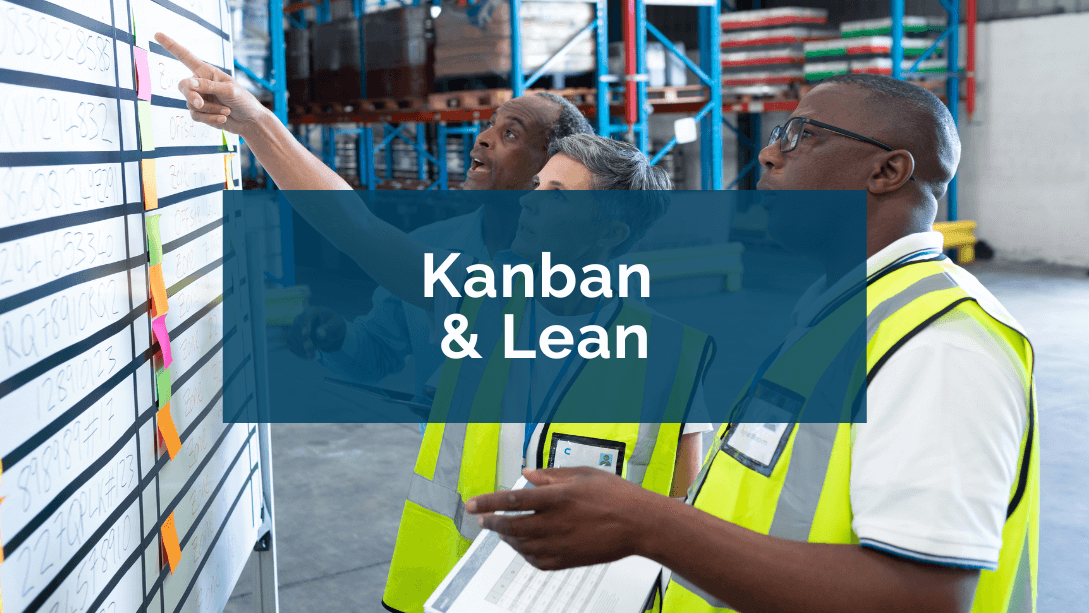What is Kanban?
Kanban is a Japanese word meaning "visual label" or "sign". This Just-In-Time production management system is based on visualization of the work in progress and the regulation of the workflow based on demand. It's a simple yet highly effective system for eliminating waste, reducing waiting times, and improving quality.
A brief history of the Kanban method
The history of the Kanban method is closely linked to Just-In-Time, a philosophy developed by Toyota. The idea was to reduce the excess inventory, waiting times, and waste associated with mass production by enabling production based on actual market demand.
Kanban was developed in the late 50s by Taiichi Ōno, a Japanese engineer working at Toyota. The goal of this method was to regulate the flow of parts and materials efficiently, in line with demand, eliminating overproduction and minimizing waste.
Initially designed for the manufacturing sector, Kanban has evolved over the last decades to become a leading project management method used in many fields, including software development.
Kanban in the context of Lean Manufacturing
In Lean Manufacturing, the Kanban method is a key tool with several important objectives:
- Reduce waste: Kanban avoids overproduction by only producing what is needed, thus reducing unnecessary stocks and associated storage costs and losses.
- Optimize workflow: By controlling workflow and avoiding overload at every stage of the Lean process, Kanban ensures a continuous, balanced flow, reducing waiting times and interruptions.
- Improve quality: The Kanban system highlights problems as soon as they arise, enabling immediate resolution and so improved product quality.
- Facilitate visual management: The Kanban method provides a clear visual representation of the production processes, making it easy for the entire team to monitor and understand the production status.
- Encourage continuous improvement: By constantly identifying problems and bottlenecks, Kanban encourages a culture of continuous improvement in the organization.
The 4 main principles of Kanban
This agile method is based on 4 fundamental principles:
1. Start with what you're doing now
This principle emphasizes the importance of starting with the current situation, processes in place, and existing practices.
Rather than reinventing the entire process, Kanban encourages teams to understand and respect the current workflow to recognize the reality of the shop floor.
2. Pursue incremental change
The Kanban approach promotes the idea that change should not be brutal but gradual.
Teams and organizations must be prepared to adopt an attitude of continuous improvement by applying incremental and evolutionary change. This promotes a smoother transition and greater acceptance of these transformations.
3. Respect existing processes, roles, and responsibilities
This principle emphasizes respect for existing staff, roles, and skills in the organization.
Kanban does not disrupt the whole system but respects and values employees' responsibilities. It aims to make existing processes more efficient, not to replace them.
4. Encourage leadership at all levels
Every worker, whatever their position or hierarchical level, can be a leader in implementing and managing Kanban practices. It’s about encouraging individual responsibility and initiative for continuous improvement.
Kanban systems: The essential elements
The key elements of the Kanban methodology are designed to provide greater insight into workflow management, production control, and continuous improvement.
Visual cues
Kanban cards are at the center of this method. Presented as cards or sticky notes, they act as visual cues to organize and guide teams' work throughout the production line.
Each card represents a work unit, a task, or an item to produce. It contains important information such as the item description, quantity, location, process step, etc.
There are two main types of kanban cards, each used for a specific purpose:
- Production Kanban: These cards are used to manage the production of parts or items. They indicate when to produce and how much to produce. When a production stage has completed a batch, it brings back the associated Kanban card at the beginning of the process to trigger the production of the next batch.
- Movement Kanban (or Transport Kanban): These cards manage the movement of materials or products between process stages. Withdrawal cards signal when to move parts from one stage to the other. When parts are consumed, the Kanban card is returned to the previous stage to authorize the withdrawal of new parts.
Defining the right number of Kanban cards
Determining the right number of Kanban cards is critical if the system is to operate efficiently. Kanban cards are designed to balance production with actual demand, minimizing waste while avoiding work overload.
The standard formula for defining the number of Kanban cards is:
Number of cards = (Daily demand x Cycle time) / Minimum order quantity
Once you've determined an initial number of Kanban cards, monitor the system and adjust as you go. If problems arise, such as delays, bottlenecks, or overstocking, reassess and adjust the number of cards accordingly.
Kanban boards (physical or digital)
The Kanban board is a visual aid that provides an overview of the workflow, enabling the whole team to keep track of work progress. It is divided into columns, each representing a stage in the production process. Kanban cards are moved from column to column as work progresses.
The representation of these traditional Kanban boards can be physical (wallboard, whiteboard, etc.). A digital Kanban system can also be implemented (Kanban software).

Work in progress (WIP) limits
WIP limits are the maximum quantities of work allowed at each process stage. They are set to prevent overloading at a given stage, which could lead to delays and inefficiencies.
When a WIP limit is reached, no new Kanban card can be moved to that stage until one of the current cards has progressed.
WIP limits encourage compliance with the workflow and the reduction of waste.
How does the Kanban method work?
Pull system and push system
The Kanban process is a pull-based method, meaning production is based on customer demand. Kanban cards, associated with tasks or items, act as visual signals to trigger the production.
When a step in the process needs more items to meet demand, it "pulls" the corresponding Kanban card, indicating to the previous step that it needs to produce more. This system ensures that only what is needed is created, thus reducing waste and excessive inventories.
It contrasts with the "push" principle, which is based on production forecasts. Items are pushed into the production process according to a schedule or demand forecast. It can lead to overproduction, unnecessary inventories, and delays when demand fluctuates.
The role of feedback loops in the Kanban system
Each feedback loop is essential to the Kanban method and plays a vital role for continuous improvement. They allow to detect problems, make adjustments, and ensure the workflow remains frictionless.
Feedback loops comprise 3 different stages:
- Problems (e.g., delays, errors, bottlenecks) are detected and reported by team members.
- Once a problem has been reported, the team resolves it immediately. This prevents the issue from getting worse or impacting the production.
- Once a problem has been solved, the team reflects on its causes and potential solutions. This leads to improvements in the work processes that eliminate the risk of recurrence in the future.
The 6 steps to implementing a Kanban system as part of Lean Manufacturing

Step 1: Create workflow visualizations
Workflow visualization involves mapping and visually representing the entire production process. It can be done using physical or digital Kanban boards, maps, or panels.
Each step in the work process is clearly defined, identified, and activated, enabling the whole team to see how work flows.
Step 2: Limit work in progress
Strict limits must be set on the number of tasks in progress at each process stage, to avoid overload, maintain a smooth workflow, and minimize waiting times.
Step 3: Manage workflows
Managing workflow involves carefully monitoring the progress of tasks or items through the process. The goal is to ensure that production proceeds smoothly, without delays or interruptions.
If anything goes wrong, corrective actions must be taken to restore the flow.
Step 4: Clearly define and share work policies
This stage involves defining the policies and rules that govern the workflow, including priorities, quality criteria, deadlines, criteria for moving from one stage to the other, etc.
These policies are communicated to the team to make sure everyone knows and understands them.
Step 5: Implement feedback loops
Team members must report problems as soon as they arise, triggering immediate actions to resolve them.
In addition, regular retrospective meetings are held to review production performance, identify areas for improvement, and make adjustments.
Step 6: Foster collaboration and experimentation for continuous improvement
The Kanban method encourages collaboration between employees, fostering a spirit of experimentation and innovation. Different teams work together to find ways of improving the process, optimizing workflows, and reducing waste.
New ideas and methods can be tested through experimentation, pushing a step further the mindset of continuous improvement.
The benefits of the Kanban method

Reduced waste and overstock
The Kanban method eliminates waste ("muda") by reducing overproduction, excessive inventories, waiting times, unnecessary movements, work overload ("muri"), quality corrections, and any other form of waste.
It also allows to better manage the variability ("mura") of demand by adapting to fluctuations, thus making production more stable.
Kanban cards ensure that only the necessary work is done.
Improved flow and yield
Kanban optimizes workflow by avoiding delays, waiting times, and interruptions. The result is more efficient production and faster processes.
Increased flexibility and responsiveness to change
The Kanban method adapts to variations in actual demand. It enables flexible production that can be quickly adjusted to respond to market changes and fluctuations.
Better visibility on production status and bottlenecks
Kanban is a method that offers real-time visibility on the state of production. Through charts and cards, everyone can see where tasks or items are in the process.
This makes it easy for teams to track progress, reduce bottlenecks, and make informed decisions on ways to solve potential problems.
Higher quality
By limiting work in progress and controlling processes step by step, the Kanban method helps to improve quality. Problems are quickly detected and resolved upstream.
Better communication and collaboration
The Kanban system encourages communication and collaboration between team members. Everyone can see what's going on in the production process and make sure they're moving in the same direction.
Kanban challenges and solutions
Demand fluctuations
Demand fluctuations can make it challenging to manage Kanban cards.
Solution: Adapt WIP limits and ensure that Kanban cards are set to handle demand variations.
Quality problems
Quality problems can lead to production delays.
Solution: Identify problems from the start, resolve them, and consider integrating quality control measures into the process.
Logistical challenges
Problems with transport or material availability can affect the Kanban system.
Solution: Communicate regularly and align with suppliers so that the logistics flow remains smooth.
Resistance to change
Employees may refrain from adopting the Kanban method.
Solution: Offer training and coaching sessions. Involve employees in implementing Kanban and show them the benefits of this method.
Implementing Kanban for continuous improvement in manufacturing
Kanban is not just a production management method. Creating a visual, responsive, and efficient work environment is a must for achieving Lean Manufacturing objectives as it embodies the core principles of this philosophy.
With accurate task visualizations, balanced production flows, reduced waiting time, and a strong culture of improvement, the Kanban method enables organizations to transform into agile, competitive structures focused on customer needs.
This method offers a great path to operational excellence while preserving the flexibility needed to adapt to variations in demand and market trends.









